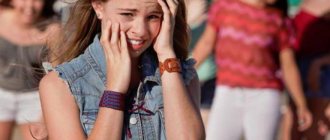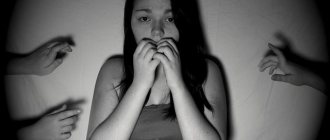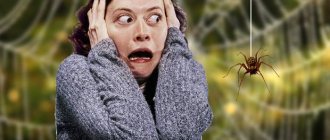The modern world is active and dynamic. The morning of the capital city begins with a crowd practically running to the subway, rushing to work. People tolerate the accelerated pace of life and large crowds of people in different ways. For some, it is a powerful charge of energy, a positive, emotional factor; for others, a large number of people causes fear and tension. In the most severe cases, this fear can develop into a phobia.
A phobia is a persistent reaction to a stimulus that a person experiences as negative. In this case, a variety of it arises called demophobia - panic fear of crowds, large crowds of people. At the moment of an attack, a person is inadequate; he sees a real serious danger where it does not exist.
The everyday crowd is incapable of causing harm. But images of the consequences caused by an uncontrolled crowd can live in the human unconscious. Everyone knows that in a moment of panic, a crowd is a huge force capable of causing great harm to others. Frightened, running, it can be extremely dangerous, where everyone is saving their life, not paying attention to others.
The modern world is filled with negative situations associated with a large number of people: traffic jams, long journeys to work, crowding in transport, television programs showing terrorist attacks, frequent mass celebrations with unpredictable consequences of an intoxicated crowd, theft of money and property in crowded places, in markets. etc. In a collective sense, fear of people is interpreted as anthropophobia.
What is the fear of crowds called?
The name of the term “Demophobia” is of ancient Greek origin. “Phobos” translated means “fear”, and “demos” means a crowd, a large number of people. It is the crowd that becomes a source of increased anxiety, fear and panic in a person suffering from this symptom. In some cases, he tends to experience fear while being directly in a crowd; some people are horrified by just contemplating it.
In each of these cases, attending rallies, concerts, meetings and other special events becomes painful for a demophobe. Even if in front of him is an ordinary event that arouses interest and has high social significance, he will protect himself from such situations. The most ardent football fan would prefer to watch the match of his favorite team at home rather than at the stadium. In some sources, this type of fear is identified with the concept of “agoraphobia” or “ochlophobia”.
What is demophobia, ochlophobia or agoraphobia and their differences
What is the name of the phobia? Agoraphobia, demophobia, ochlophobia. Let's try to understand the differences between these concepts.
What is agoraphobia? This is a fear of open space, or a fear of squares. But what frightens a person is not so much the square itself as the fact that he will feel bad, and no one will be able to help or will not notice it. That is, we can say that he is frightened by the reaction and behavior of the crowd.
Demophobia is the fear of large crowds of people. For example, a person is frightened by rallies, traveling on public transport, queues, etc. This is a fear of a lot of people. Demophobes are frightened by any crowd of people.
Ochlophobia is the fear of random, unorganized crowds of people. This is the difference between an ochlophobe and a demophobe. The first one will not be frightened by a crowd of people who are united by at least some common goal, for example, they will not be frightened by museum visitors or a line at the ticket office. But a chaotic crowd of people in the subway or on the street frightens the ochlophobe.
Currently, all three names are used as synonyms for each other. It is believed that ochlophobia and demophobia are outdated names for agoraphobia. It is also generally accepted that there is a slight difference between ochlophobia and demophobia, which will be interesting and important only for a psychiatrist during diagnosis. In general, the mechanism of development, manifestations and methods of treatment are the same for all three phobias.
What is an ochlophobe afraid of? Behind each of these phobias lies the fear of losing control, being in danger, or dying. A person cannot be responsible for the actions of all members of the crowd, and this frightens him; he feels vulnerable and helpless.
Unprimitive fear
The symptom of fear of crowds is called a phobia of the 21st century, it is characteristic of residents of densely populated cities. The specific environment of megacities has a negative impact, in which rush hour occurs almost 24 hours a day, and vehicle traffic does not stop on the streets. Sad news about terrorist attacks committed in various parts of the world and claiming the lives of many people does not subside on television - all these factors create the preconditions for the formation of the disorder.
Among the main reasons for its occurrence, psychoanalysts note:
- excessive stress placed on the nervous system. A work schedule overloaded with urgent matters and a series of unpleasant events becomes a serious psychologically traumatic factor;
- emotional turmoil suffered in childhood. Problems at the stage of personality formation always leave a negative imprint on the character and behavior of an adult. Fear of crowds of people arises due to conflicts with peers and lack of proper support from parents. This is how a program is laid in the subconscious, the main message of which is that people pose a potential threat;
- Negative personal experiences are also a common cause of the symptom. Fear from a crush in the subway, bus or once experienced violence leads to the emergence of social deviations, including fear of large crowds of people;
- excessive suspiciousness causes negative experiences. A critical assessment of others, even if insignificant, implants in the subconscious the idea that society is unsafe and hostile.
Like any phobia, fear of crowds of people is irrational. That is, a person suffering from panic attacks cannot explain what she is really afraid of. Often a demophobe does not control his emotions and sensations, does not control the flow of obsessive ideas and does not think that the fear is actually unfounded. Convulsive attempts to analyze the situation and understand your experiences only complicate the situation - this is fraught with the appearance of psychological discomfort that interferes with normal life activities.
Fear of crowds of people is inherent not only to ordinary people, but also to famous personalities. Singer Alena Apina admitted in an interview with StarHit about what she experiences when going on stage. “Before every time I go on stage, my legs give way. One thing is good: the fear goes away by itself after two or three songs. It wasn't always like this. In 2000, I was told a story about my colleague, singer Dmitry Malikov: during his performance, a heavy glass bottle was thrown from the audience at the artist. “It impressed me so much that now, until I feel the mood of the audience, I can’t completely relax.” The singer explains this phobia, which is not typical for a public person, by her personality type: “I’m an introvert, I need personal space. So between a big company and the opportunity to be alone, I will, without a doubt, choose the latter.”
Basic information about demophobia
There are two main terms that mean the same thing - demophobia (literally - fear of people) and oxlophobia (literally - fear of crowds). There is also agoraphobia, which is often confused with demophobia. But these are fears of different etiology, and we will distinguish the differences later.
About 0.4% of the total population suffers from demophobia. These are mainly residents of large and densely populated cities.
Pathology refers to functional mental disorders of a reversible nature.
When there is heavy traffic and traffic jams on the road, hypermarkets are full of people, public transport is crowded, and you can’t find a free table in a cafe at lunch – you begin to get mentally tired. Even for those who do not suffer from phobias, being in a crowd can cause irritation and even aggression.
Some people are able to mentally abstract themselves from the masses and everything that happens around them. Others react to any external stimuli and experience stress. But there are those who have large crowds of people and bustle, causing panic.
Often, a demophobe cannot explain what exactly frightens him in a crowd. It is completely natural to feel fear in a crowd that has experienced general panic (for example, during a terrorist attack in a public place).
In such situations, people running, scared, create a powerful force that can destroy many obstacles in its path. Everyone knows that in such situations there are victims, crushed and trampled.
But with demophobia, a person begins to be frightened by absolutely any crowds of people, even completely peaceful ones. It is extremely difficult for a demophobe to travel on public transport during rush hours or enter premises with large crowds of people. And various folk festivals, rallies, parades with noise and drunk people can cause severe panic.
A person with oxlophobia experiences obsessive thoughts and constantly imagines negative pictures associated with their fear.
When the phobia is severe, the sufferer begins to experience unpleasant symptoms, even when simply observing a crowd, for example, on a TV screen or looking out a window.
On a note! A person suffering from a phobia is not affected by persuasion, such as: “calm down, there is no danger here” or “stop beating yourself up.” He is aware of his pathological fear, but is unable to control it, and is unable to cope with the reaction of his psyche.
How to recognize crowd fear
As soon as a person imagines a large crowd of people, intense fear immediately appears, which is difficult to overcome. This is observed only in a particularly advanced form of the disorder. Symptoms are the result of various factors, so the intensity varies for each person and depends on the conditions in which they find themselves. The larger the crowd and the less support the demophobe receives at the moment of collision with it, the more unpleasant and destructive the symptoms will be.
Fear of crowds occurs on three levels: physical, cognitive and behavioral. Physical manifestations arise primarily as a consequence of the activity of the central nervous system.
If your loved one suffers from demophobia, be attentive to the following signs in order to provide help and quell the growing anxiety:
- increased heart rate and breathing rate;
- feeling of lack of air;
- muscle tension leading to headaches or discomfort in the gastrointestinal tract;
- unnatural dilation of pupils;
- increased sweating;
- dizziness.
Physical manifestations of crowd fear are quickly interpreted, analyzed by the brain and become cognitive. There is an awareness of one's fear and the possible danger of overcrowding in a confined space. In order to avoid consequences, an irresistible desire appears to leave this place and be safe, away from the object of the phobia. At this stage, the thought of personal inability to survive in the current situation plays an important role. Note that when you try to take control of your thoughts and curb your fear, the further development of panic fear stops. Otherwise, it moves to a new level - behavioral. The only acceptable solution for someone who has a fear of crowds is to run away, avoiding close contact with crowds in any way possible.
Many people confuse the symptom with the wariness inherent in every person who finds himself in a crowd of strangers. It should be understood that a phobia is an irrational feeling that manifests itself at the very sight of an object of fear or at the thought of it.
Let's consider the main signs that distinguish pathological fear of a large number of people from rational caution:
- a sudden feeling of danger turning into panic;
- feeling of hopelessness and self-doubt;
- fear of getting lost among strangers;
- acute hostility towards each of the crowd;
- the need to protect oneself from every member of the crowd.
A person who has realized the relationship between anxiety and crowds of people radically changes his life. It all starts with a strict restriction of your movement: all crowded places are excluded from the route. The path usually passes along deserted roads - they come with a feeling of relief and a kind of joy from the fact that there are no people here. The fear of crowds, if measures are not taken to eliminate it, quickly progresses and the demophobe begins to lead a reclusive lifestyle. The symptom is often accompanied by newly formed fears, mental and somatic diseases.
Causes of panic fear
The appearance of such pronounced states always has its own background. As a rule, the prerequisites that give rise to demophobia are laid in childhood, when personal space and the child’s sense of it are formed. If it is constantly violated, the child may have problems with people in later life, especially if we are talking about a large concentration of them.
Such a child, growing up, will be more often exposed to traumatic situations that are associated with people or a group of people. And if, as an adult, he suffers severely from a crowd or simply from situations involving individuals, then he may develop demophobia.
Demophobia also occurs as a concomitant factor in mental illness and nervous disorders.
All those people with whom we travel in transport, walk down the street, are in a room are in invisible contact with us, we can experience an emotional reaction when looking at them, experiencing discomfort from human touches, smells, etc. These impressions can influence our personal space.
Each person has their own distance. By establishing it with other people and interacting with them, he feels safe. For demophobes, such a distance does not exist; they are extremely susceptible to others. A person whose boundaries have been constantly violated since childhood will feel great discomfort when surrounded by other people. With a large number of interactions, a person may have a constant desire to “run away” from the crowd, to be alone. If no measures are taken, this process will intensify, and tension in contact with people will increase. Don't expect intense fear to go away on its own. Symptoms that appear once will be repeated again and again. Help yourself in ways that you find acceptable.
Panic fear of crowds, like any other phobia, is a defensive reaction. It helps a person protect himself and his own borders. Highly sensitive people maintain their personal space by avoiding large crowds of people, choosing a small group of those with whom they feel comfortable.
Demophobia: how to determine if people are afraid
You can overcome the fear of crowds once and for all by diagnosing the symptom in a timely manner. Making a diagnosis is only within the competence of a psychiatrist (since this may be only one of the symptoms of other disorders - schizophrenia, dementia or psychosis). The specialist conducts a comprehensive diagnosis, which includes anamnesis - collecting information about the patient’s childhood, conditions of personality development, work, residence and social environment.
The anamnesis contains both subjective and objective information:
- information from the patient himself about the course of the disease, when its signs first appeared and what events preceded it. It is worth paying attention to memories of childhood and family, facts of abuse of mind-altering substances. Information about past illnesses, injuries and infections is taken into account;
- An anamnesis about the disease is collected from the client’s friends and relatives: when and under what conditions it appeared. It is important to obtain information from parents about developmental features in childhood.
Close people of a person suffering from fear of crowds are asked the same questions as a demophobe. It is important to identify discrepancies in answers, find out what facts the client kept silent about and what life events he imagined in a different light.
To make a correct diagnosis, a psychotherapist or psychiatrist uses the following method:
- rating scales and special questionnaires;
- observing the patient's behavior and speech patterns.
Don't let anxiety turn into a phobia!
Be attentive to yourself and analyze your own condition. Awareness of the “here and now” is important in the fight against anxiety and excessive impressionability. If you have discovered one or more symptoms of demophobia, do not draw premature conclusions. You can overcome increased anxiety on your own, without a psychologist or psychotherapist.
To do this, use the following recommendations:
- When you feel approaching anxiety, look around you for potential danger from those around you. After a few seconds, you will notice that everyone is busy only with their own thoughts and affairs. For them, you are the same ordinary background as the rest of the passers-by;
- The voice of a familiar person whom you trust has a calming effect in many cases. Call your mother, sister or old friend on the phone - this way you will be distracted, gain more strength and confidence;
- a person in a restless state does not see people like himself in a crowd. To him, everyone seems like a faceless gray mass. Talk to someone in the crowd, ask any question like “what time is it?” or “where is the street...?” Having received a calm, adequate answer, you will be able to assess the situation more adequately, make sure that there is no reason to panic;
- try to feel yourself, your physical body. Pay attention to your breathing: it should be deep and even. Psychotherapists recommend focusing on your breathing in order to quickly relax, organize your thoughts and relieve an acute condition. To learn breathing practices perfectly, you may need to repeat them several times.
Causes of demophobia
The disorder in question occurs during puberty. The cause of the disease may be evidence of public shame, mass violence or an accident with a large crowd of people. Quite often, such disorders develop in people who have survived a terrorist attack.
Let's imagine a situation where a fire breaks out in a movie theater. People in the hall fall into mass panic, which causes dire consequences. A crowd of people running towards the exit can crush and fatally injure others. A person who has experienced such events may be in a state of severe shock. The human psyche is designed in such a way that, in order to avoid serious disorders, defensive reactions are triggered, one of which may be fear of public places. According to experts, this disorder is based on social causes associated with negative life experiences.
Medical treatment for fear of crowds
The path to getting rid of any phobia is interaction with a psychotherapist or psychiatrist. In psychology, there are several effective techniques that are practiced in order to overcome the fear of crowds of people. Although not everyone is able to turn to a stranger for help, you need to understand that only this can restore hope for a fulfilling life. If you feel that fear is crossing all boundaries and preventing free communication, movement, work and personal life, do not hesitate to contact a professional.
If you are part of the circle of trust of a person with a similar symptom, reassure him and suggest a joint visit to the doctor. Do not perceive his behavior as whim or manipulation. For him, fear is a reality that cannot be adequately perceived. Do not insist on meeting with strangers, describe the entire route in detail and provide him with the security he so needs.
The specialist, in turn, will offer one or more options for psychocorrection:
- searching for the root cause of fear, recognizing a traumatic situation;
- development of a new model of behavior;
- debunking myths around unfounded fears;
- modeling everyday situations in which the client takes on different roles;
- regressive or progressive hypnosis.
Psychiatry does not provide medications for the treatment of crowd fear. Drugs that calm the nervous system only help smooth out phobic manifestations and tune into a positive mood. It is possible to undergo successful socialization and restore the ability for interpersonal and social contacts when the psychotherapist and the patient work together.
Demophobia is a huge cage that is narrowing every day. Don't forget: the world is full of unforgettable emotions, bright events and pleasant moments. Without communication, life loses its taste and meaning. Don't be a victim of fear, find the strength to say “I'm not afraid anymore” and fight it!
Prevention
Preventive measures can be divided into primary and secondary prevention. Primary involves the care of parents for the child. Demophobia is a social phobia, a form of maladjustment. It is necessary to take care of the child’s socialization and help him develop communication skills. Secondary prevention is carried out in adulthood and involves people working independently on themselves. It is important to monitor your health, work through all injuries, and not suppress problems and negativity.
It is important! If you cannot cope with any traumatic situation on your own, then consult a psychologist.
Treatment methods
It is important to pay attention to the fact that carriers of this phobia need the help of an experienced psychologist. An attempt at self-medication can only aggravate the situation and cause complications . In the first stages of therapy, it is very important to correctly diagnose the disorder and identify the causes of its occurrence. Drug treatment involves the use of mild antidepressants in combination with drugs that reduce anxiety.
Psychotherapeutic correction involves the use of cognitive behavioral therapy and desensitization methods. The success of therapy depends on the severity of the disorder, the individual characteristics of the patient’s psyche and the correctness of the prescribed treatment.











